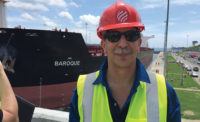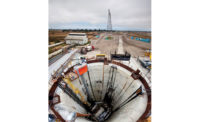Panama Canal Expansion Wraps Up
Panama Canal crews put finishing touches on the third lane and race to demobilize as the June 26 inauguration approaches

Sprint to Finish Crews also put finishing touches on the exterior of the Pacific side’s control tower. By the time officials hold the project’s inauguration ceremony on June 26, all the equipment in the background will be cleared away and the site will have been remediated, allowing space for thousands of Panamanian dignitaries and spectators to gather. Photo by Scott Blair/ENR

Opening for Business Three 1,400-ft-long locks at each end of the canal are designed to raise or lower New Panamax-class ships. A tugboat operator carefully guided the first ship through the new locks during a successful test run on June 9. Each gate takes about four minutes to open or close. Photo by Scott Blair/ENR

Opening for Business Three 1,400-ft-long locks at each end of the canal are designed to raise or lower New Panamax-class ships. A tugboat operator carefully guided the first ship through the new locks during a successful test run on June 9. Each gate takes about four minutes to open or close. Photo courtesy Salini Impregilo

Opening for Business Three 1,400-ft-long locks at each end of the canal are designed to raise or lower New Panamax-class ships. A tugboat operator carefully guided the first ship through the new locks during a successful test run on June 9. Each gate takes about four minutes to open or close. Photo by Scott Blair/ENR




Panama’s 10-year, $5.4-billion effort to add a third set of locks culminated on June 9, as tugboats guided a 255-meter-long bulk carrier, named Baroque, into the first lock. While not as large as the 366-m-long New Panamax ships the locks were designed to accommodate, the vessel’s passage marked the first full-scale test of the complex electrical-mechanical system.
“Everything worked according to plan,” says Ilya Espino de Marotta, executive vice president for the Panama Canal Authority (ACP).
In the days leading up to the first commercial ship passage, scheduled for June 26, the ship will pass through the locks multiple times, as part of the commissioning. Thousands of dignitaries and Panamanians will be on hand to witness the canal’s first new lane opening in more than 100 years.
But the celebration won’t mark the cessation of construction activity. After a peak of about 13,000 workers, contractor consortium Grupo Unidos por el Canal (GUPC) still employs about 4,000 workers at the two lock sites at either end of the canal. These crews are completing access roads and performing final fitout of about 96 buildings, totaling more than 430,000 sq ft, while executing a complex demobilization effort.

“The close-out of the project is still a very big machine.”
–Giuseppe Quarta, CEO, Grupo Unidos por el Canal (GUPC)
“More than a year ago, we created a separate sector with a project manager just for demobilization,” says Giuseppe Quarta, CEO of GUPC, which includes Spain’s Sacyr S.A., Italy’s Salini Impregilo S.p.A., the Netherlands’ Jan De Nul n.v. and Panama’s Constructora Urbana. A 300-employee demobilization staff assesses, rehabilitates, sells or scraps hundreds of vehicles and pieces of heavy equipment; dismantles complex temporary facilities, including some of the largest crushing plants and concrete batch plants in the world; and navigates reams of paperwork involved with costs, permitting and exporting.
“This is not equipment that you can easily sell. We have to go through specialized auction firms,” he says.
The plants that produced the project’s 4.7 million cu m of concrete already have been dismantled and packed into shipping containers. Crews currently are restoring these sites to their original condition.
Meanwhile, another team of 100-plus employees are cranking out some 80,000 quality certificates and 16,000 as-built drawings. “The close-out of the project is still a very big machine,” Quarta says.
During the months of commissioning, the project’s 16 gates have been opened and closed more than 100 times. Unlike the two existing lanes, which use miter gates that swing open, the third lane uses 10-m-wide, 57.6-m-long, 33-m-high gates that move perpendicularly. As a gate opens between one of the three locks at each end of the canal, it nestles into a recess, similar to a pocket door.
Last year, during the initial round of gate tests, insufficient reinforcement opened a large crack in a concrete sill underneath one of the gates on the Pacific side, leading to water seepage.
“In the lapse of three weeks from discovering the leak, we understood what the problem was and how to fix it,” Quarta says. Crews repaired the sill by drilling and installing additional rebar into the crack. Five additional sills were reinforced as a precaution and to ensure the system’s 100-year design lifetime. GUPC resequenced commissioning to cut what would have been a four-month delay down to “just a couple of months,” Quarta adds.
In all, the project incorporated 250,000 tons of reinforcing steel. Another 71,000 tons of steel comprises the gates and 152 valves, which play a critical role in the gravity-fed system that fills and empties the locks. Water stored in expansive water-saving basins flows at 33,000 cu m per minute to fill or empty each lock chamber in just seven minutes, according to Alessandro Zaffaroni, GUPC commissioning engineer. The basins are designed to reduce freshwater usage by up to 60%.
So far, “the filling system is working really well,” Zaffaroni says.
Even after the opening ceremony, hundreds of workers will remain on site for several months to perform punch-list items and other work. A smaller GUPC crew will stay on for a three-year maintenance period, stipulated in the design-build contract.
Over the six-year construction period, the project has employed more than 50,000 people, the vast majority Panamana nationals. By providing technical and safety training, GUPC leaves the nation with a more qualified workforce, says Quarta. Local subcontractors unaccustomed to megaproject environments “were scared to enter into our standard contract with liquidated damages and key milestones … but now they have contract management experience and are ready to face bigger things,” he adds.
Ongoing Dispute
Last year’s sill repairs, plus earlier delays caused by problems with the original concrete mix and a GUPC work stoppage in early 2014 over disputed claims, added about one and a half years to the original project schedule.
Depending on the ongoing arbitration process, the budget could significantly swell. More than $2 billion in claims put forth by GUPC remain unresolved. These cost disputes could drag on for another two years, at least. An agreement between ACP and GUPC stipulates that both must put forth “best efforts to resolve all of the claims by 2018,” Marotta says.
One such outstanding claim involves about $234 million awarded to GUPC last year by the project’s Dispute Adjudication Board due to the site’s poor-quality basalt—a key ingredient in the concrete mix. Both sides appealed the decision to a final arbitration council, in Miami. GUPC seeks an additional $345 million, and ACP contends that no monies should be awarded, Marotta says.
However, even if ACP “ends up paying more, this is a very successful project because of what it’s going to do for Panama’s economy,” says Peter Wallace, executive vice president with Hill International, a U.S.-based firm providing project oversight and auditing services to ACP. “The revenue stream from this project is going to be substantial, even with the slowdown of global growth.”
ACP has identified several lessons learned. A formal partnering session at the onset of the project could have prevented difficulties later on, Marotta says. She also would favor consortiums that have worked together on previous projects, with one firm having a clearly established leadership role.
While Wallace says the design-build delivery method was the right choice for the ambitious project, he would have advised ACP to include a requirement in the request for proposals that the designer be an equity partner in the consortium. “The fact that [GUPC] subcontracted this [provision] created a problem,” he says.
Despite the disputes, Marotta says ACP continues to see “good competition” on bids for other projects, and the authority has several projects coming out to bid in the near future.









